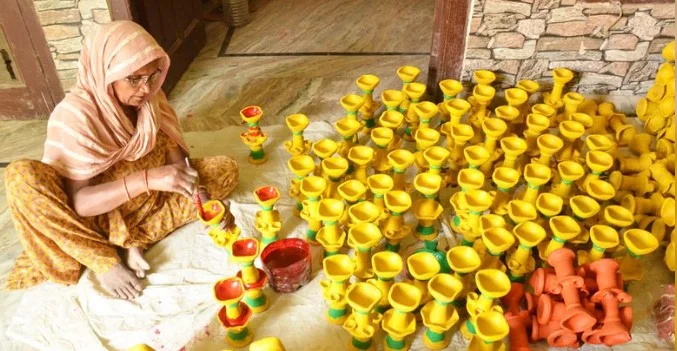Chandigarh, October 16, 2025: Days before Diwali, the festival of lights, markets across Punjab are brimming with terracotta items, including diyas, Hatri, Chandol, Pari, Haathi (elephant), Ghoda (horse), and idols used in Diwali pujas. Diyas of various shapes and sizes are also on display, reflecting the age-old Punjabi tradition of lighting oil lamps.
Experts note that these items offer a glimpse into the past when earthen lamps were the primary source of illumination after sunset. The figurine “Pari” has space to place wicks in its hands, while Hatri resembles a one-room house with provision for multiple lamps on its top. Chandol, larger than regular diyas, has four sides for wicks, and the tower-like Diwali lamp features multiple places for wicks around its body and on top.
Bhola, a trader and potter, said, “A Diwali prayer remains incomplete without terracotta Haathi, Ghoda, and idols of Ganesha and Lakshmi. Being earthen, these are considered pure, and after the ritual, they are released into running water.”
The tradition has roots tracing back to the Harappan era, now located in Pakistan’s Punjab, and continues to thrive in modern celebrations. Ravi Kumar, a young potter, urged customers to value the creativity and labour behind each piece, rather than considering them simple clay objects.
Crafting terracotta items involves multiple labour-intensive steps: the earth is dried, pounded into powder, mixed with water, sieved, kneaded, shaped, sun-dried, and fired in a hearth for three to four days before being painted in vibrant colours.
Apart from local creations, idols of Lakshmi, Ganesha, and others are also sourced from Agra and Lucknow. Local artisans focus on Diwali, Hatri, elephants, horses, Pari, and Kandola (a pot for holding prasad).
Rajiv, a potter in Khidoneyan Wala Bazaar, said sales peak during festivals and school projects often feature traditional trades. “Customers are willing to pay more if the terracotta items are well-made and attractive,” he noted. Prices range from ₹10 for six small diyas, ₹20–40 for Hatri, ₹50–80 for Diwali lamps, and ₹50–80 for Kandola and Chandol.
Despite the digital age and alternative entertainment options, the enthusiasm of residents and artisans continues to keep this centuries-old craft alive.

